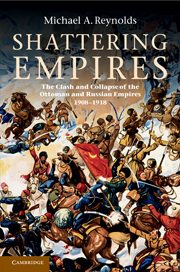Book contents
- Frontmatter
- Contents
- List of plates
- List of maps
- Note on transliteration and usage
- Acknowledgments
- List of abbreviations
- 1 Dismemberment of the Ottoman empire, 1878–1913
- 2 Eastern Anatolia and the Caucasus, 1914
- 3 Partition plans for Anatolia, 1915–1917
- 4 Borders in the Caucasus, 1918
- 5 The Turkish Republic and the Soviet Union, 1923
- Introduction
- 1 The high politics of anarchy and competition
- 2 Troubles in Anatolia: imperial insecurities and the transformation of borderland politics
- 3 Visions of vulnerability: the politics of Muslims, revolutionaries, and defectors
- 4 Out of the pan and into the fire: empires at war
- 5 Remastering Anatolia, rending nations, rending empires
- 6 Brest-Litovsk and the opening of the Caucasus
- 7 Forced to be free: the geopolitics of independence in the Transcaucasus
- 8 Racing against time
- Epilogue
- Select bibliography
- Index
- Plate section
4 - Out of the pan and into the fire: empires at war
Published online by Cambridge University Press: 05 June 2012
- Frontmatter
- Contents
- List of plates
- List of maps
- Note on transliteration and usage
- Acknowledgments
- List of abbreviations
- 1 Dismemberment of the Ottoman empire, 1878–1913
- 2 Eastern Anatolia and the Caucasus, 1914
- 3 Partition plans for Anatolia, 1915–1917
- 4 Borders in the Caucasus, 1918
- 5 The Turkish Republic and the Soviet Union, 1923
- Introduction
- 1 The high politics of anarchy and competition
- 2 Troubles in Anatolia: imperial insecurities and the transformation of borderland politics
- 3 Visions of vulnerability: the politics of Muslims, revolutionaries, and defectors
- 4 Out of the pan and into the fire: empires at war
- 5 Remastering Anatolia, rending nations, rending empires
- 6 Brest-Litovsk and the opening of the Caucasus
- 7 Forced to be free: the geopolitics of independence in the Transcaucasus
- 8 Racing against time
- Epilogue
- Select bibliography
- Index
- Plate section
Summary
On 28 June 1914, a young Bosnian Serb terrorist decided to ignore last-minute orders from the Serbian army's General Staff to scrub his mission and fired two shots, killing the Austro-Hungarian heir apparent Archduke Franz Ferdinand and his wife in Sarajevo, the capital of the former Ottoman province of Bosnia. Austria-Hungary, backed by Germany, moved against Serbia on 28 July. The “Third Balkan War” had begun. Russia mobilized in response, spurring Germany to declare war on both Russia and its ally, France, lest it wait and find itself trapped between the Russian steamroller coming from the east and the French in the west. By 3 August war had engulfed the continent of Europe. The Eastern Question that had bedeviled the Ottomans had not disappeared with their retreat, but had remained to plunge Europe and much of the world into the greatest cataclysm humankind had yet witnessed.
The outbreak of war presented a dilemma to the Ottomans. On the one hand, this time the war did not directly involve them, and they were not ready for another. As Enver had advised his fellow cabinet members in the spring, the Ottoman army needed at least five years of peace before it would be ready for a major war. On the other hand, it was not clear that they could have the luxury of sitting it out. General expectations in Europe and elsewhere were that the war would revise the balance of power in Europe and beyond.
- Type
- Chapter
- Information
- Shattering EmpiresThe Clash and Collapse of the Ottoman and Russian Empires 1908–1918, pp. 107 - 139Publisher: Cambridge University PressPrint publication year: 2011



